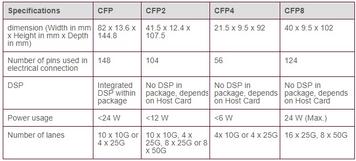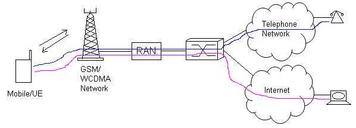
CFP vs CFP2 vs CFP4 vs CFP8 Optical Transceivers: Key Differences
Explore the differences between CFP, CFP2, CFP4, and CFP8 optical transceivers, including size, power usage, bandwidth, and DSP integration.
Showing 20 posts (Page 27 of 162)
Advertisement

Explore the differences between CFP, CFP2, CFP4, and CFP8 optical transceivers, including size, power usage, bandwidth, and DSP integration.

Explore the key differences between CFP and CXP transceivers, focusing on specifications like density, signaling, media, and power consumption.

Explore the key differences between CFP and QSFP28 transceivers, including specifications, applications, dimensions, and front panel density.

Learn about CFP (C Form Factor Pluggable), its specifications, and different types like CFP, CFP2, CFP4, and CFP8 used in high-speed networking.

Explore the benefits and drawbacks of channel bonding for faster internet speeds using Wi-Fi, cellular, and ADSL connections. Understand the pros and cons before implementation.
Character stuffing and bit stuffing are crucial data communication techniques that prevent control characters/bits from being misinterpreted as data. Learn the differences and examples.

Comparison of Chase Combining HARQ and Incremental Redundancy HARQ techniques, detailing their differences and applications in wireless communication systems.

Explore the advantages and disadvantages of chatbots, from cost-effectiveness and AI power to limitations in query resolution and complex decision-making.

Explore the benefits and drawbacks of ChatGPT, an AI-powered chatbot. Understand its features, capabilities, and limitations compared to traditional search engines.

Explains the distinction between 'chip' and 'chirp' in LoRaWAN, clarifying their roles within Chirp Spread Spectrum (CSS) modulation for long-range, low-power communication.
Explore different control strategies for choppers (DC-DC converters), including PWM, voltage mode, current mode, hysteresis, sliding mode, and feedforward control. Understand their advantages and applications.

Explore the Cicret Bracelet, a wearable device projecting smartphone interfaces onto your skin. Learn about its components, functionality, and potential applications.

Explore the differences between CIRC encoding and decoding used in CD systems for error detection and correction, along with the benefits of CIRC encoder.

Explore the differences between circuit-switched and packet-switched calls. Understand how they work, their best applications, and call flow examples for GSM and WCDMA networks.

A breakdown of circuit switching (CS) and packet switching (PS) in telecommunications, highlighting their differences and applications in voice and data networks.

Explore the pros and cons of circuit switching, a network type using dedicated channels. Learn about its use in voice communication and resource utilization.
Explore circuit and network digital twins in 6G wireless, focusing on component-level hardware and large-scale network simulations to enhance performance and efficiency.

Explore the benefits and drawbacks of circular polarization in radio waves, including reduced interference and fixed polarization, against higher costs and shorter RFID read ranges.

Explore circular waveguide mode suppressors, their function in eliminating unwanted modes in RF systems, benefits, and industrial applications for efficient signal transmission.

Explore the S-matrix representations of 3-port and 4-port circulators, essential components in RF systems for signal routing.
Advertisement